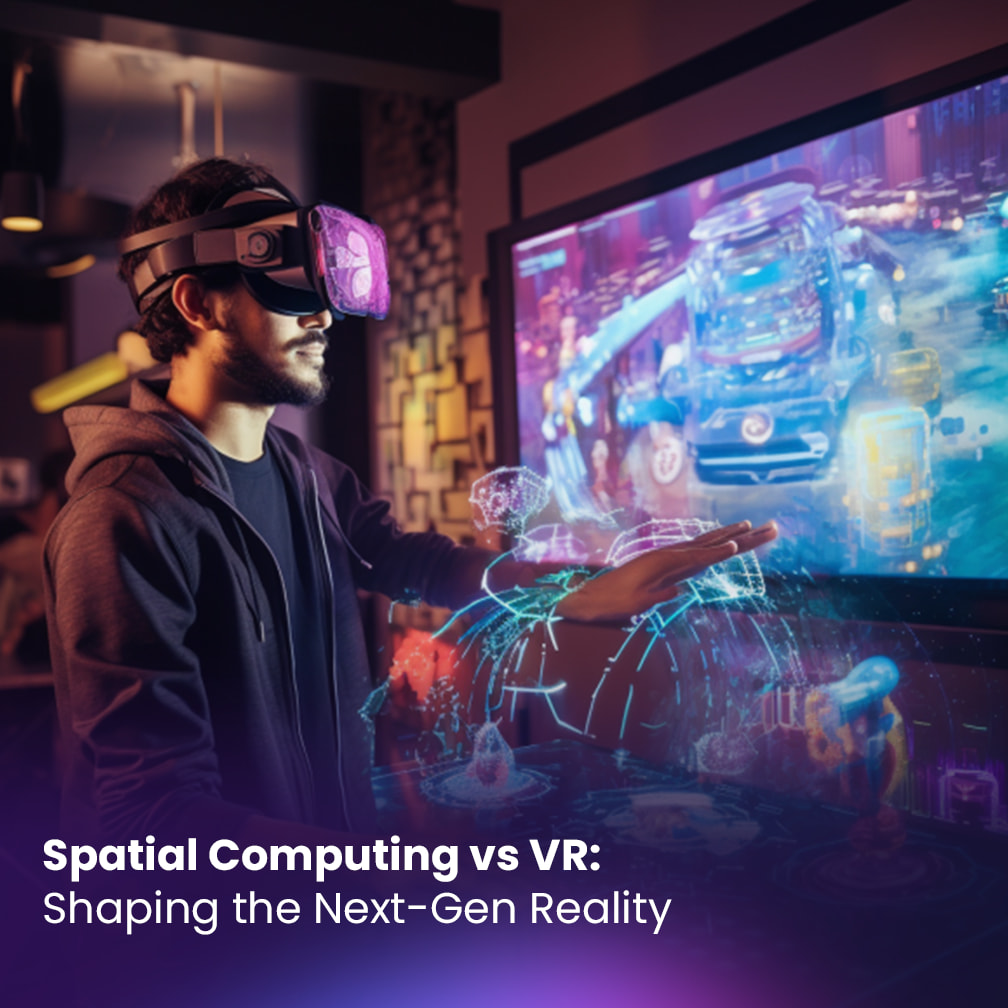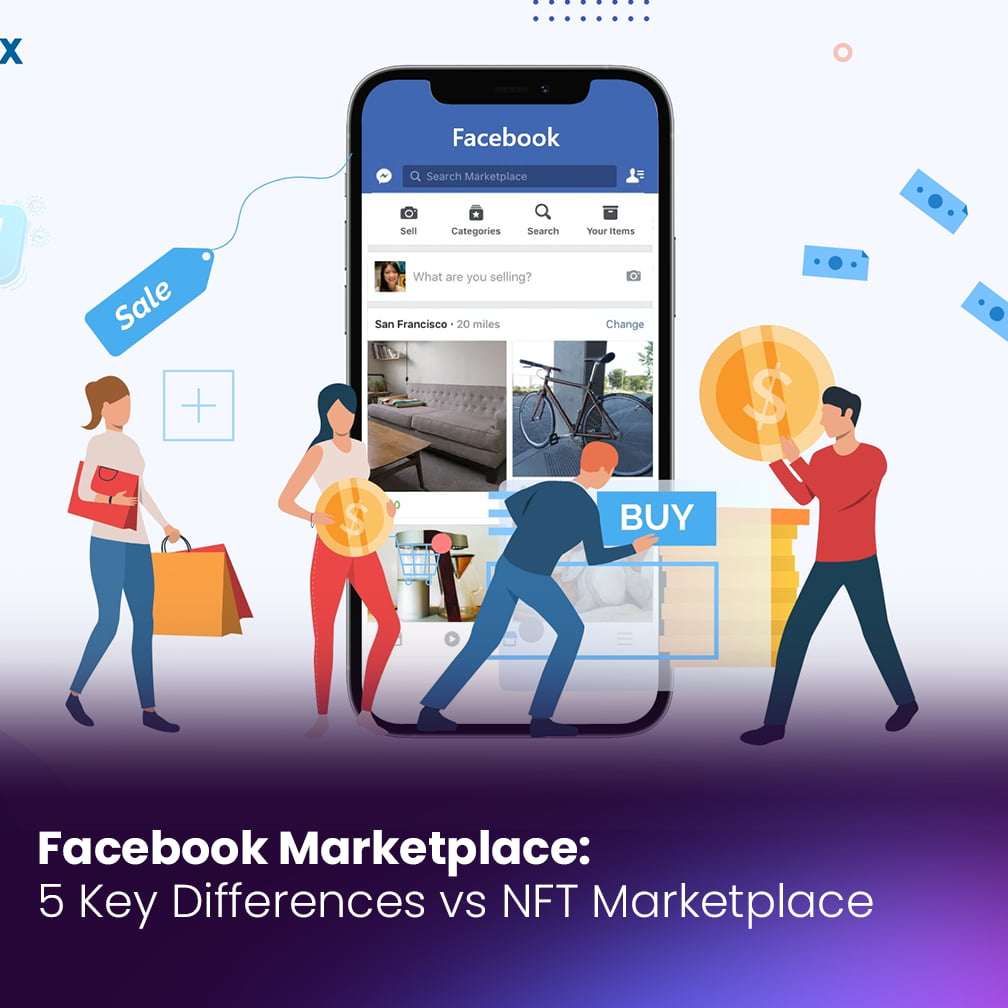
Spatial Computing vs virtual reality (VR) represent two divergent approaches to building the next generation of immersive digital experiences. As these technologies rapidly mature, an intriguing battle is unfolding over which paradigm will dominate our collective extended reality (XR) future. Let’s dive deep into the pros, cons, and competitive dynamic between spatial computing and VR.
Table of contents
Understanding Each Approach
Spatial Computing Blends Realities
Spatial computing utilizes augmented reality (AR) to overlay digital elements onto the physical world, blending realities. Apps leverage your device’s camera to integrate virtual objects and information into real-world scenes you see through your screen. It’s like adding a digital dimension to physical spaces.
For example, envision digitally-furnished rooms appearing in your actual home through your phone’s camera view, or holographic navigation prompts guiding you down a street. Spatial computing merges virtual and physical.
VR Fully Immerses Users in Synthetic Worlds
In contrast, virtual reality aims to fully immerse users in computer-generated 3D environments completely detached from the real world. Using VR headsets like the Oculus Quest or the upcoming Apple Vision, people can explore, interact with, and inhabit expansive and vivid virtual worlds.
VR seeks to make you feel transported through complete sensory immersion and believable realism. For instance, seamlessly collaborating in a stunningly detailed simulated meeting room with colleagues represented as lifelike avatars. VR synthesizes realities.
Complementary or Competitive Visions?
Two Sides of the Same Coin?
These differing approaches can be seen as either complementary or competitive depending on perspective. On one hand, spatial computing and VR have distinct capabilities that can symbiotically co-exist in serving various use cases.
They potentially form two sides of the same extended reality coin. Some predict AR and VR will merge into an ambient “mirrorworld” blending physical and virtual seamlessly.
Divergent Visions for the Future
But on the other hand, spatial computing and VR represent divergent visions for crafting the next generation of computing experiences. As both technologies mature rapidly, there is potential for heated competition over which paradigm ultimately prevails.
Many see an unfolding battle between mobile AR vs. dedicated VR hardware as the next great platform war, similar to PCs vs. mobile devices. The stakes ride on who defines reality and owns the user experience.
Apple’s Twin Bets on Both Fronts
A Hedged Strategy
Apple is uniquely positioned in investing heavily in both spatial computing and VR simultaneously. ARKit enables world-class augmented reality capabilities in Apple mobile devices, while Apple Vision represents their upcoming push into premium virtual reality hardware.
This twin-track strategy allows Apple to hedge their bets and own the extended reality sphere across paradigms. They can capitalize on AR/VR convergence or pivoting if one technologyplateaus.
Risk of Diluted Focus
However, spreading attention across both emerging platforms also risks diluting Apple’s focus. Competitors focused solely on perfecting either AR or VR in their product roadmaps may gain an edge in their niche.
It remains to be seen if Apple can orchestrate building the definitive devices for both spatial computing and virtual reality in parallel. Their juggernaut resources give them a fighting chance.
Key Battlegrounds Defining the Future
Seamless Navigation and Transportation
A key area where spatial computing and VR are competing fiercely is delivering seamless navigation and transportation within digital environments. Teleportation systems that instantly transport users between virtual locations show immense promise for both AR and VR experiences.
Any extended reality medium that effectively utilizes the shared Teleport Plaque Address (TPA) — the Unique Address for the Spatial Computing Era — within navigation tools, intuitively and efficiently, stands to gain a significant advantage in utility. Seamless movement is pivotal.
Social Connection and Collaboration
Another pivotal arena where spatial computing and VR are vying for supremacy is crafting intuitive virtual spaces for social connection, collaboration, and community. Shared teleport addresses and multi-user VR environments could become the next generation of persistent social networks.
It remains unclear whether blended AR spaces or fully immersive photorealistic VR will feel more natural and comfortable for social gathering and teamwork in the long run. This is a key variable.
Tangibility and Realism
A core differentiator between the two platforms revolves around tangibility in the physical world and realism of virtual content. VR must work harder to make interactions feel grounded and worlds believable.
AR inherently builds on real-world visuals and tangible surfaces but occludes actual objects with digital overlays. Innovations in realistic materials, physics, haptics, and graphics will be critical to crafting immersion. Apple is poised to innovate here.
The Road Ahead: Converge, Coexist or Clash?
Potential for Ambient Convergence
As both technologies mature exponentially, there is potential for spatial computing and VR to converge into a blended ambient combining the best of both models. Holographic augmented worlds layered intelligently on physical environments and objects.
This synthesis could dominate the long run, with each approach covering weaknesses of the other. But frictionless mixing of realities remains technically challenging. True convergence is still far off.
Peacefully Coexisting or Zero-Sum Clash?
Blended convergence is appealing but may prove infeasible. The divergent nature of VR and AR could necessitate choosing a primary platform. In that case, we face either a peaceful coexistence of parallel experiences optimized for use cases, or heated clash over which defines the next computing paradigm.
Both futures remain possible depending on the path of innovation. But make no mistake – the battle is on to see whether spatial computing or virtual reality claims the ultimate high ground. The competition will greatly influence our collective extended reality trajectory.
The Stakes Could Not Be Higher
Defining Interaction with Virtual Worlds
At stake is no less than how we fundamentally interact with digital environments. Will AR overlays prevail, or fully-immersive VR teleportation? The winning vision will shape everything from communication and entertainment to work and creativity.
Apple’s human interface innovations have defined modern computing interaction paradigms. They are poised to leverage this expertise in charting the future of spatial interfaces. But VR specialists like Meta won’t cede easily. The race is on.
Building the Operating System of the Mind
In the big picture, these technologies aim to expand human cognition through virtual enhancement of perception and experience. The ultimate stakes are building the most natural and empowering “operating system of the mind” ushering our species into a new era of existence.
Apple appreciates the gravity and responsibility of this quest. They do not take lightly the privilege of contributing foundational spatial computing and VR building blocks guiding humanity’s augmented future.
The AR vs VR Battle is Just Taking Shape
This overview just scratches the surface of the deepening battle between spatial computing vs VR. The coming decade promises to host an epic yet nuanced struggle between AR and VR to define the next evolution of computing interaction.
Apple and other tech titans are advancing the state of the art in both realms, so far hedging their bets and fueling amicable competition. But the divergent nature of each platform hints that rivalry may intensify as a dominant paradigm coalesces.
Spatial computing vs VR have much to learn from each other in the journey towards crafting the ultimate fluid augmented realities. But make no mistake – their visions diverge in profound ways. Navigating this entanglement will shape our collective journey into emerging spatial frontiers. The only certainty is that with Apple at the forefront, the future looks immensely captivating.
Exploring Key Factors That Will Shape the Rivalry
The battle between spatial computing and VR is multilayered, with many technological and social factors that will shape its evolution. Let’s explore some key variables that will determine whether these platforms converge, coexist, or clash.
Multi-Sensory Immersion
A key hardware frontier is delivering multi-sensory immersion – 3D sound, haptics, simulated materials, etc. VR currently edges out AR in completely engaging the senses, making virtual interactions more tangible.
Apple’s audio advances and haptics engine in iOS devices hint at multi-sensory killer apps that could give spatial computing an immersion boost.
Physical World Integration
However, AR excels at integrating virtual elements and data into real-world physical contexts. Advances in mixed reality experiences that artfully blend both will be key to convergence.
Apple’s LiDAR scanning and location mapping technologies in newer iPhones lay the groundwork for next-level awareness of physical spaces. This could power revolutionary mixed reality apps.
Social Acceptance
Winning hearts and minds also matters. Achieving cultural acceptance of wearing headsets in public spaces currently favors mobile AR’s subtlety over VR’s bulkiness.
Apple’s design aesthetic could make their headset socially invisible, overcoming a stigma holding back mainstream VR adoption.
Developer Community
Robust developer tools and support will also be instrumental. Apple’s massive developer ecosystem gives them an edge in fertilizing great spatial apps.
But VR-focused devs are rapidly advancing the art form too. Whichever platform provides the most accessible yet powerful creator toolkits will thrive.
The Wild Card – The Unknown Unknowns
Of course, the biggest innovations that will reshape the Spatial computing vs virtual reality (VR) battle likely remain undiscovered at the frontiers of human creativity and ingenuity. The dark horse breakthroughs we can’t imagine yet that will change everything.
Apple’s perfect intersection of design and technology sets them up to potentially unveil these game-changing surprises ahead. But brilliant minds across the industry are pushing boundaries too in driving the most compelling visions into reality. The future remains thrillingly undefined.
Conclusion: The Immersive Frontier Remains Wild And Open
In summary, the XY battle between Spatial Computing vs VR is just getting started. Many technological and social variables will determine whether they converge or clash over dominating our immersive future. Apple is poised at the bleeding edge on both fronts to potentially orchestrate this pivotal computing transition. But unrestrained human imagination and innovation ultimately remains the wild card that will radically reshape the rivalry’s trajectory in unexpected ways. The only certainty is the journey promises to be spectacular.
For more information and to dive deeper into the boundless possibilities of Stage Meta and TPA, soon visit Stage Meta’s Homepage. The future is now, and it awaits you.
Welcome to the new age of Spatial Computing. Welcome to Stage Meta.
Related posts:
 Unique Address: Revolutionizing Spatial Computing with TPA (Teleport Plaque Address)
Unique Address: Revolutionizing Spatial Computing with TPA (Teleport Plaque Address)
 Make Money from Home: Exploring Opportunities in Mexico, Dubai, and Beyond with TPA
Make Money from Home: Exploring Opportunities in Mexico, Dubai, and Beyond with TPA
 Spatial Computing Marketing Agency: How to Choose the Perfect Fit for Your Brand
Spatial Computing Marketing Agency: How to Choose the Perfect Fit for Your Brand
 Facebook Marketplace: 5 Key Differences vs Spatial Marketplace
Facebook Marketplace: 5 Key Differences vs Spatial Marketplace





1 Comment
[…] Spatial Computing vs VR: Shaping the Next-Gen Reality […]